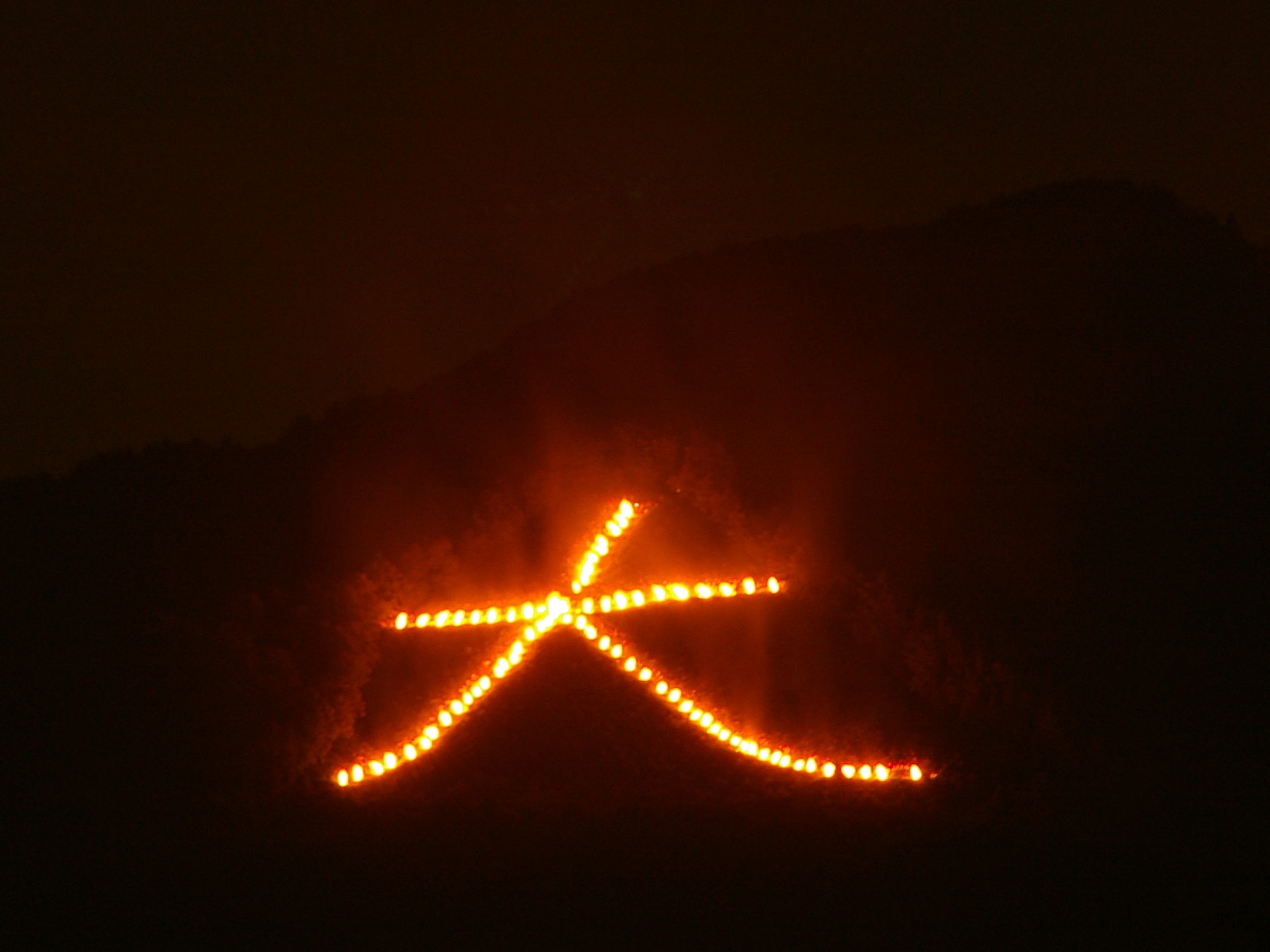Gozan no Okuribi on:
[Wikipedia]
[Google]
[Amazon]

 , more commonly known as , is a festival in Kyoto,
, more commonly known as , is a festival in Kyoto,
Website about with further descriptions of the bonfires
Description of in a Kyoto city tourist guide
Website about with further descriptions of the bonfires (in English)
{{DEFAULTSORT:Gozan No Okuribi Religion in Kyoto Tourist attractions in Kyoto Festivals in Kyoto Hill figures Geoglyphs Buddhist festivals in Japan Traditions involving fire Japanese words and phrases

 , more commonly known as , is a festival in Kyoto,
, more commonly known as , is a festival in Kyoto, Japan
Japan ( ja, 日本, or , and formally , ''Nihonkoku'') is an island country in East Asia. It is situated in the northwest Pacific Ocean, and is bordered on the west by the Sea of Japan, while extending from the Sea of Okhotsk in the north ...
. It is the culmination of the Obon festival on August 16, in which five giant bonfire
A bonfire is a large and controlled outdoor fire, used either for informal disposal of burnable waste material or as part of a celebration.
Etymology
The earliest recorded uses of the word date back to the late 15th century, with the Catho ...
s are lit on mountains surrounding the city. It signifies the moment when the spirits of deceased family members, who are said to visit this world during Obon, are believed to be returning to the spirit world—thus the name .
History
The origins of the festival are obscure, but it is believed to be ancient. Specific families have the hereditary duty of organizing all the logistics of the bonfires, and they spend many hours annually providing volunteer labor to maintain this tradition.Schedule
Starting at 8 pm, the giant bonfires are lit, each with a distinctive shape. Three of the fires form giant kanji characters, and two form familiar shapes. The characters, their locations, meanings, and the lighting times are: *, the character meaning "large" or "great", is lit on Daimonji-Yama/Higashi-Yama, Nyoigatake at 8 pm; *, the characters meaning "wondrousdharma
Dharma (; sa, धर्म, dharma, ; pi, dhamma, italic=yes) is a key concept with multiple meanings in Indian religions, such as Hinduism, Buddhism, Jainism, Sikhism and others. Although there is no direct single-word translation for '' ...
" (referring to Buddhist teachings), are lit on Matsugasaki, Nishi-Yama/Higashi-Yama at 8:10 pm;
*, the shape of a boat, is lit on Nishigamo, Funa-Yama at 8:15 pm;
*, again, the character meaning "large", is lit on Daihoku-San, Hidaridaimonji-San at 8:15 pm;
*, the shape of a shrine gate, is lit on Toriimoto, Mandara-San at 8:20 pm.
The most famous—and the first to be lit—is the character , on Kyoto's . The other four fires are lit at five to ten-minute intervals, and by 8:30, all the characters can be seen. Each bonfire lasts for 30 minutes.
The 2020 event was significantly scaled back, due to COVID-19, with only six points of lit and one point lit at each of the other four locations.
Viewing spots
The best place to view the festival is from the Nakagyō Ward, in the center of the city. Many hotels have specials where, for a fee, one can see all five fires. Many people also like to go to the Kamo River, between Sanjo and Imadegawa Streets, for an excellent view of the initial fires. More specifically, the following spots are mentioned as good viewing spots:Latitude and longitude
*Daimonji: *Myō: *Hō: *Funagata: *Hidari Daimonji: *Toriigata:References
External links
Website about with further descriptions of the bonfires
Description of in a Kyoto city tourist guide
Website about with further descriptions of the bonfires (in English)
{{DEFAULTSORT:Gozan No Okuribi Religion in Kyoto Tourist attractions in Kyoto Festivals in Kyoto Hill figures Geoglyphs Buddhist festivals in Japan Traditions involving fire Japanese words and phrases